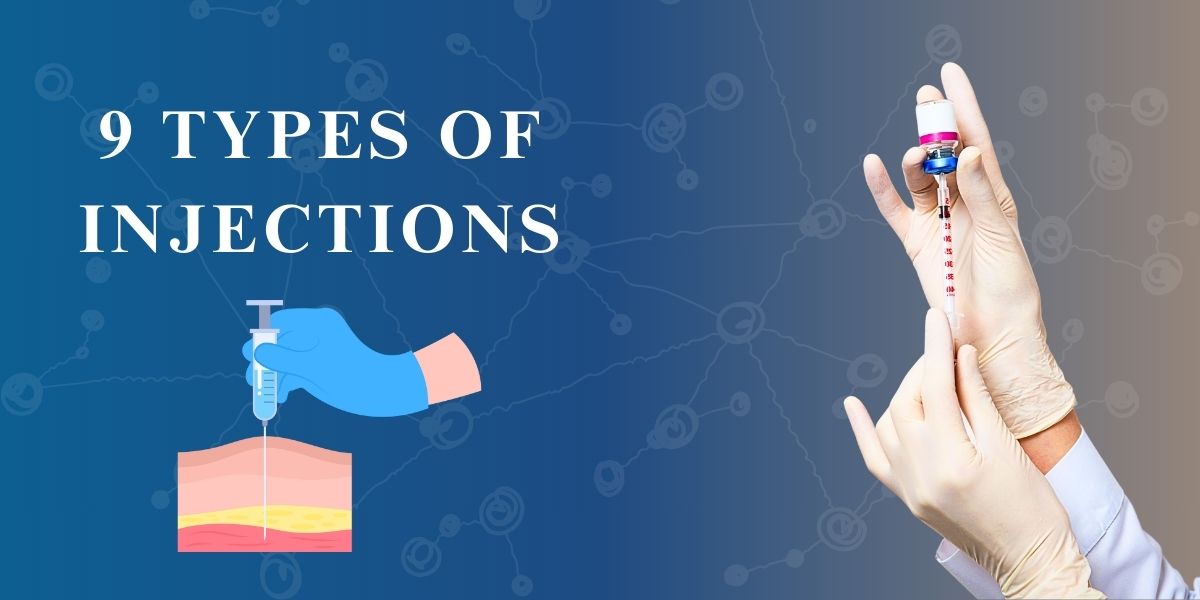Blog
9 Types of Injections: Uses, Sites & Benefits Explained

Introduction of 9 types of injections
Injections are one of the most common ways to deliver medicines directly into the body. Whether it's for a quick pain relief shot, vaccines, or insulin, injections help deliver medicine faster and more effectively. But did you know there are different types of injections used for different purposes? In this guide, we’ll break down 9 types of injections, how they work, and why they are used.
1. Intramuscular (IM) Injections
Uses:
Intramuscular injections are delivered directly into the muscle. They're commonly used for vaccinations, pain relievers, hormone therapy, and antibiotics.
Benefits:
- Fast absorption of medication.
- Suitable for drugs that can't be taken orally.
- Long-lasting effect for some medications.
Side Effects:
- Pain or soreness at the injection site.
- Swelling or redness.
- Rarely, nerve damage if improperly administered.
2. Subcutaneous (SC) Injections

Uses:
Subcutaneous injections are given into the fatty tissue under the skin. They are commonly used for insulin (for diabetes), hormones, and blood thinners like heparin.
Benefits:
- Slow and steady absorption of medication.
- Convenient for self-administration (like insulin).
Side Effects:
- Mild bruising or swelling.
- Redness or irritation.
- Rare allergic reaction.
3. Intravenous (IV) Injections
Uses:
IV injections deliver medicine directly into the bloodstream, making them ideal for emergencies, hospital treatments, and chemotherapy.
Benefits:
- Immediate effect since it enters the bloodstream.
- Controlled dosage for precision.
Side Effects:
- Risk of infection at the injection site.
- Vein irritation.
- Allergic reactions in some cases.
4. Intradermal (ID) Injections
Uses:
Intradermal injections are administered into the skin's top layer, often used for allergy testing and tuberculosis (TB) tests.
Benefits:
- Minimal amount of medication needed.
- Ideal for diagnostic tests.
Side Effects:
- Minor swelling or redness.
- Itchiness or irritation.
- Small risk of infection if not properly cleaned.
5. Depot Injections
Uses:
Depot injections are long-acting and slowly release medication over time. Common in hormone therapies, contraceptives, and antipsychotics.
Benefits:
- Long-term medication delivery (weeks to months).
- Great for patients who struggle with daily doses.
Side Effects:
- Pain at injection site.
- Mood changes depending on the medication.
- Hormonal side effects (e.g., weight gain, acne).
6. Epidural Injections
Uses:
Given around the spinal cord, epidural injections are widely used for labor pain, chronic back pain, and surgical anesthesia.
Benefits:
- Targeted pain relief.
- Reduces need for oral painkillers.
Side Effects:
- Headache (rare).
- Temporary weakness or numbness.
- Risk of infection (minimal if done properly).
7. Intra-articular Injections
Uses:
These are injections directly into joints, often used for arthritis, joint pain, and inflammation.
Benefits:
- Direct relief at pain source.
- Reduces inflammation effectively.
Side Effects:
- Joint infection (very rare).
- Temporary swelling or discomfort.
8. Intrathecal Injections
Uses:
Injected directly into the spinal canal, often used for spinal anesthesia, cancer treatment, or severe pain management.
Benefits:
- Fast-acting for central nervous system issues.
- Requires smaller drug doses due to direct delivery.
Side Effects:
- Headache.
- Nausea or dizziness.
- Risk of infection if hygiene is compromised.
9. Z-track Injections
Uses:
A type of intramuscular injection where the skin is pulled to prevent leakage of medication back to the surface, used for iron supplements and other irritating medications.
Benefits:
- Prevents medication from leaking out.
- Reduces skin irritation.
Side Effects:
- Pain at site.
- Possible swelling.
General Benefits of Injections:
- Faster absorption compared to oral medications.
- Higher bioavailability (more medicine reaches where it's needed).
- Controlled dosage without relying on digestion.
Common Side Effects to Watch Out For:
- Pain, redness, or swelling at the injection site.
- Rare but serious: allergic reactions or infection.
- Dizziness or nausea in sensitive individuals.
Final Thoughts
Injections are a cornerstone of modern medicine, offering fast, targeted, and effective treatment options. Knowing the types of injections, their uses, benefits, and potential side effects helps patients make informed decisions and feel more comfortable with their treatment. Always ensure that injections are administered by a trained professional to minimize risks and maximize benefits.
If you have any concerns or questions about your medications, consult your healthcare provider for personalized advice.
Frequently Asked Questions (FAQs)
1. Which type of injection is most commonly used?
Intramuscular (IM) and subcutaneous (SC) injections are among the most common, used for vaccinations and long-term medications like insulin.
2. Are injections painful?
Most injections cause a quick pinch or mild discomfort. Pain can vary depending on the injection type, medication, and individual sensitivity.
3. Can I take injections at home?
Certain injections like insulin (SC) can be safely taken at home after proper guidance from a healthcare provider. Others like IV or intrathecal injections require medical supervision.
4. How long does it take for an injection to work?
- IV injections: almost immediate effect.
- IM injections: minutes to an hour.
- SC injections: several minutes to hours depending on medication.
5. What should I do if I notice a rash or swelling after an injection?
Mild swelling is normal, but if you notice severe redness, swelling, or difficulty breathing, seek immediate medical help — it may indicate an allergic reaction.